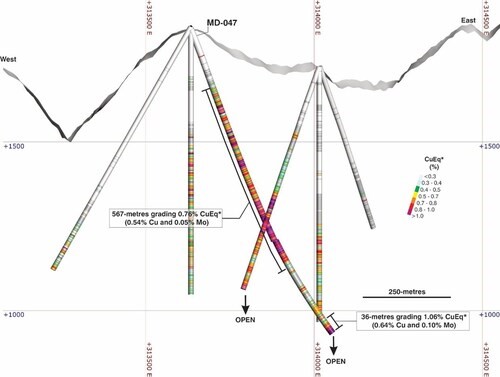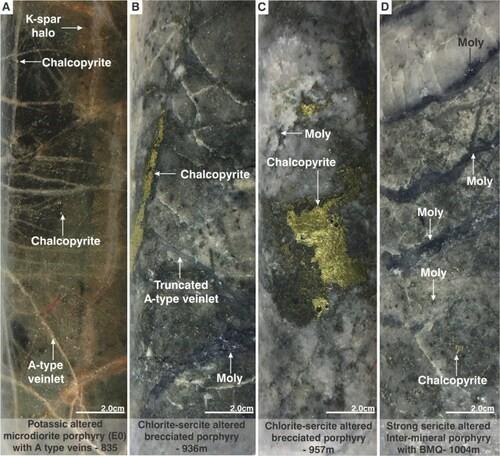
COPPER GIANT EXTENDS MOCOA’S NEAR SURFACE HIGH-GRADE WITH 567-METRES AT 0.54% COPPER & 0.07% MOLYBDENUM

- Hole MD-047 returned 1,004-metres of continuous copper and molybdenum mineralization from surface with the entire hole averaging 0.57% CuEq* (0.39% Cu and 0.04% Mo)—highlighting one of the most robust mineralized intervals drilled at Mocoa to date.
- Grades intensify toward depth, with multiple high-grade intervals—including: 126-metres at 0.99% CuEq* (0.62% Cu and 0.09% Mo) and the final 36-metres of the hole grading 1.06% CuEq* (0.64% Cu and 0.10% Mo) (see Table 1 and Figure 2).
- High grades are hosted in newly identified early-stage and inter-mineral porphyry in addition to breccia phases—confirming that Mocoa’s high-grade potential extends beyond previously recognized breccia zones and opens new vectors for targeting.
- New structural insights from Mocoa reveal consistent orientations in the copper and molybdenum-bearing veins. These are now being integrated into 3D modeling to enhance targeting of the most prospective zones in upcoming in-fill and step-out drilling.
Copper Giant Resources Corp. (TSX-V: CGNT) (OTCQB: LBCMF) (FRA: 29H0) is pleased to announce full assay results for hole MD-47 which ended at 1,004 metres due to drill capacity, further constrained by the wedge installation that reduced the maximum achievable depth. The hole is part of the Company’s 14,000-metre resource expansion program at its flagship Mocoa porphyry copper-molybdenum project in Putumayo, Colombia. MD-47 has extended the high-grade core of the system to depth and confirmed the orientation of bulk copper and molybdenum mineralization. Drilling remains active with two drills operating at full capacity.
“Hole MD-047 is one of the most exciting holes we’ve drilled recently and has significantly advanced our understanding of the Mocoa system. Beyond the exceptional grades, MD-047 gives us clear evidence of a broader and deeper high-grade system than we had modeled. Discovering new intrusive phases and ending the hole in strong mineralization, including a final interval over 1% CuEq, opens a new vector in the system, pointing to additional high-grade potential we hadn’t modeled. Ending the hole in such strong mineralization, without the ability to go deeper, leaves us wondering just how much more there is below.” — Edwin Naranjo Sierra, Vice President of Exploration.
Hole MD-047
Hole MD-047 was extended beyond its originally planned depth based on the strength and continuity of visible mineralization and multi-stage veining observed at depth. Detailed description and partial assay results of the first 489-metres of the hole was released on June 25, 2025. Below this depth (and up to 830-metres downhole), the hole intercepted an inter-mineral porphyry (I1) pervasively altered by sericite with localized remnants of K–feldspar alteration. This interval hosts a complex network of well-developed A type veinlets crosscutting early dark micaceous (EDM) veinlets alongside abundant chalcopyrite as C-type veinlets that overprint molybdenite rich B-type veinlets. From 830 to 862-metres, the hole intercepted a potassic-altered early microdiorite porphyry (E0) characterized by abundant A-type veining (Figure 2A), crosscut by B- and C-type veins, a key indicator of early mineralizing events and subsequent overprinting phases within the Mocoa porphyry system. Below this depth, the hole intercepted a brecciated porphyry with chalcopyrite and molybdenite occurring as matrix infill (Figure 2B and 2C), further supporting the interpretation of a long-lived, multi-phase mineralizing system. MD-047 bottomed at 1,004 metres in a silica-altered intra-mineral porphyry (I1) (Figure 2D) with stockwork of A-type veining, localized disseminated molybdenite and chalcopyrite within the matrix and banded molybdenite quartz (BQM) veins.
| MD-047 | From (m) |
To (m) |
Interval (m) |
Cu
(%) |
Mo
(%) |
CuEq*
(%) |
| 0 | 1,004 | 1,004 | 0.39 | 0.04 | 0.57 | |
| and including | 187 | 1,004 | 818 | 0.47 | 0.05 | 0.68 |
| and including | 187 | 754 | 567 | 0.54 | 0.05 | 0.76 |
| and including | 393 | 754 | 360 | 0.54 | 0.07 | 0.82 |
| and including | 593 | 719 | 126 | 0.62 | 0.09 | 0.99 |
| and including | 969 | 1,004 | 36 | 0.64 | 0.10 | 1.06 |
Table 1 – Full assay results for drill hole MD-047. *Copper equivalent (CuEq) for drill hole interceptions is calculated as: CuEq (%) = Cu (%) + 4.2 × Mo (%), utilizing metal prices of Cu – US$4.00/lb and Mo – US$20.00/lb and metal recoveries of 90% Cu and 75% Mo. Grades are uncut. Mineralized zones at Mocoa are bulk porphyry-style zones and drilled widths are interpreted to be very close to true widths. Note: For the first 489-metres assay results refer to news release dated June 25, 2025 and table 2.
The C-type veinlets, which host the bulk of the copper mineralization, exhibit two dominant orientations: 125°/50° and 250°/65° (Dip Direction/Dip). Furthermore, the B-type veinlets, including Banded Quartz-Molybdenite (BQM) veins, which are the primary carriers of molybdenum, display two main trends: 120°/20° and 250°/75°. This new structural information is being integrated into the 3D copper and molybdenum grade distribution model to better constrain the high-grade core of the Mocoa system and enhance sub-targeting for future in-fill drilling. This new information is being integrating to the copper and molybdenum grade distribution 3D model to better constraint the high-grade core of the system and provide a better high-grade sub-targeting for further in-fill drilling at Mocoa.
| MD-047 | From (m) |
To (m) |
Interval (m) |
Cu
(%) |
Mo
(%) |
CuEq*
(%) |
| 0 | 489 | 489 | 0.35 | 0.02 | 0.45 | |
| including | 187 | 489 | 303 | 0.54 | 0.03 | 0.67 |
| and including | 395 | 489 | 94 | 0.53 | 0.05 | 0.74 |
Table 2 – Partial assay results for drill hole MD-047 released on June 25, 2025. *Copper equivalent (CuEq) for drill hole interceptions is calculated as: CuEq (%) = Cu (%) + 4.2 × Mo (%), utilizing metal prices of Cu – US$4.00/lb and Mo – US$20.00/lb and metal recoveries of 90% Cu and 75% Mo. Grades are uncut. Mineralized zones at Mocoa are bulk porphyry-style zones and drilled widths are interpreted to be very close to true widths.
Qualified Person and Technical Notes
Edwin Naranjo Sierra, Vice-President of Exploration of Copper Giant is the designated Qualified Person within the meaning of National Instrument 43-101 – Standards of Disclosure for Mineral Projects (“NI 43-101”) and has reviewed and approved the technical information in this news release. Mr. Naranjo holds an MSc. in Earth Sciences and is a Fellow of the Australasian Institute of Mining and Metallurgy (FAusIMM).
Mineralized zones at Mocoa are bulk porphyry-style zones and drilled widths are interpreted to be very close to true widths.
Copper Giant operates according to a rigorous Quality Assurance and Quality Control protocol consistent with industry best practices. Core diameter is a mix of HQ and NQ depending on the depth of the drill hole. Diamond drill core boxes were photographed, sawed, sampled and tagged in maximum 2-metre intervals, stopping in geological boundaries. Samples were bagged, tagged and packaged for shipment by truck from Copper Giant’s core logging facilities in Mocoa, Colombia to the ActLabs certified sample preparation facility in Medellin, Colombia. ActLabs is an accredited laboratory independent of the Company. Samples are processed in the Medellin facilities where they are analyzed for copper and molybdenum by 4-Acid digest Atomic Absorption (AA) analysis. The sample pulps are air freighted from Medellin to the ActLabs certified laboratory in Guadalajara, Mexico, where they are analyzed for a suite of 57 elements using 4-Acid digest and ICP-MS. In order to monitor the ongoing quality of assay data and the database, Copper Giant has implemented QA/QC protocols which include standard sampling methodologies, the insertion of certified copper and molybdenum standard materials, blanks, duplicates (field, preparation and analysis) randomly inserted into the sampling sequence. QA/QC program also includes ongoing monitoring of data entry, QA/QC reporting and data validation. No material QA/QC issues have been identified with respect to sample collection, security and assaying.
About the Mocoa Porphyry System
The Mocoa project is located in the department of Putumayo, approximately 10 kilometres from the town of Mocoa in southern Colombia. Copper Giant holds a district-scale land package of over 790 square kilometres through granted titles and applications, covering a substantial portion of the Jurassic porphyry belt – an underexplored and highly prospective metallogenic zone in the northern Andes.
Discovered in 1973 through a regional geochemical survey by the United Nations and the Colombian government, Mocoa has been the subject of multiple exploration campaigns. Between 1978 and 1983, follow-up work included geological mapping, IP and magnetic geophysics, surface sampling, drilling, and metallurgical testing. Additional drilling by B2Gold in 2008 and 2012 helped shape the current geological understanding.
The deposit is hosted in Middle Jurassic dacite and quartz-diorite porphyries intruding andesitic to dacitic volcanics, within Colombia’s Central Cordillera. This 30-kilometre wide tectonic belt extends into Ecuador and hosts other major porphyry systems like Mirador, Warintza, San Carlos, and Panantza. Mocoa displays a classical porphyry-style alteration zonation: potassic core, sericite halo, and outer propylitic zone, with mineralization consisting of disseminated chalcopyrite and molybdenite, and local bornite and chalcocite, associated with stockworks and hydrothermal breccias.
The system features over 1,000 metres of vertical continuity, overlapping hydrothermal stages, and a broad alteration footprint. Multiple intrusive phases, brecciation events, and vein generations suggest a dynamic magmatic-hydrothermal evolution likely driven by more than one porphyry center.
Mocoa remains open in all directions, with several satellite targets identified across the broader land package. These features support the interpretation of a district-scale porphyry system and position Mocoa as one of the most significant undeveloped copper-molybdenum assets in the Andes
1 For further information refer to NI 43-101 Technical Report, entitled “Technical Report on the Mocoa Copper-Molybdenum Project, Colombia”, dated January 17, 2022, prepared by Michael Rowland Brepsant, FAusIMM, Robert Sim, P.Geo, and Bruce Davis, FAusIMM. with an effective date of November 01, 2021.
About Copper Giant
Copper Giant Resources Corp. is part of the Fiore Group, a private and well-established Canadian organization known for building successful, high-impact companies across the natural resource sector. Copper Giant was formed with a singular focus: to advance high-quality copper projects beyond resource definition—responsibly, efficiently, and with long-term positive impact.
The Company is led by a team with uncommon experience, having successfully taken some of the few major copper mines developed in the past two decades from discovery through to construction.
Copper Giant’s current focus is the Mocoa copper-molybdenum deposit in southern Colombia, one of the largest undeveloped resources of its kind in the Americas. Recent exploration success has revealed potential well beyond its original footprint, highlighting Mocoa as a broader district-scale opportunity—and the catalyst for the Company’s name and evolution.
Guided by the values of respect and responsibility, and grounded in its Good Neighbor philosophy, Copper Giant is committed to creating enduring value for all stakeholders and playing a meaningful role in the global energy transition.

Figure 1. Cross-section along the hole MD-047 with a projection influence of 25m. *Copper equivalent (CuEq) for drill hole interceptions is calculated as: CuEq (%) = Cu (%) + 4.2 × Mo (%), utilizing metal prices of Cu – US$4.00/lb and Mo – US$20.00/lb and metal recoveries of 90% Cu and 75% Mo. Grades are uncut. Mineralized zones at Mocoa are bulk porphyry-style zones and drilled widths are interpreted to be very close to true widths. For MD-47: azimuth of 70-degrees and dipping 68-degrees. Coordinates are UTM system, zone 18N and WGS84 projection. Hole collar is 313634E, 137883N and 1834 m.a.s.l. (CNW Group/COPPER GIANT RESOURCES CORP.)

Figure 2. Mineralization and hydrothermal alteration observed in MD-047. A). Potassic altered early microdiorite porphyry (E0). B). Chlorite-sericite altered brecciated porphyry with molybdenite (moly) and chalcopyrite as matrix-infill. C). Chlorite-sericite altered brecciated porphyry with a massive chalcopyrite. D). Strong sericite altered dacite porphyry with banded molybdenite quartz veins. (CNW Group/COPPER GIANT RESOURCES CORP.)
MORE or "UNCATEGORIZED"
Kuya Silver Confirms High-Grade Silver-Gold Vein Mineralization at Umm-Hadid with Initial Drill Results up to 1483.9 g/t AgEq over 2 Metres
Kuya Silver Corporation (CSE: KUYA) (OTCQB: KUYAF) (FSE: 6MR1) is... READ MORE
First Phosphate Closes Final Tranche of Oversubscribed Private Placement
First Phosphate Corp. (CSE: PHOS) (OTCQX: FRSPF) (FSE: KD0) is... READ MORE
GFG Receives Final Payment from the Sale of its Rattlesnake Hills Gold Project
GFG Resources Inc. (TSX-V: GFG) (OTCQB: GFGSF) announces that i... READ MORE
Goliath Receives $1,730,882 Through Warrant Exercises, Inclusive Of Crescat Capital A Longtime Strategic And Cornerstone Shareholder
Goliath Resources Limited (TSX-V: GOT) (OTCQB: GOTRF) (FSE: B4IF)... READ MORE
Robex Pours First Gold at Kiniéro on Schedule and Budget
Highlights: Gold bar weighing 2.64 kilograms (85 oz) poured in th... READ MORE












